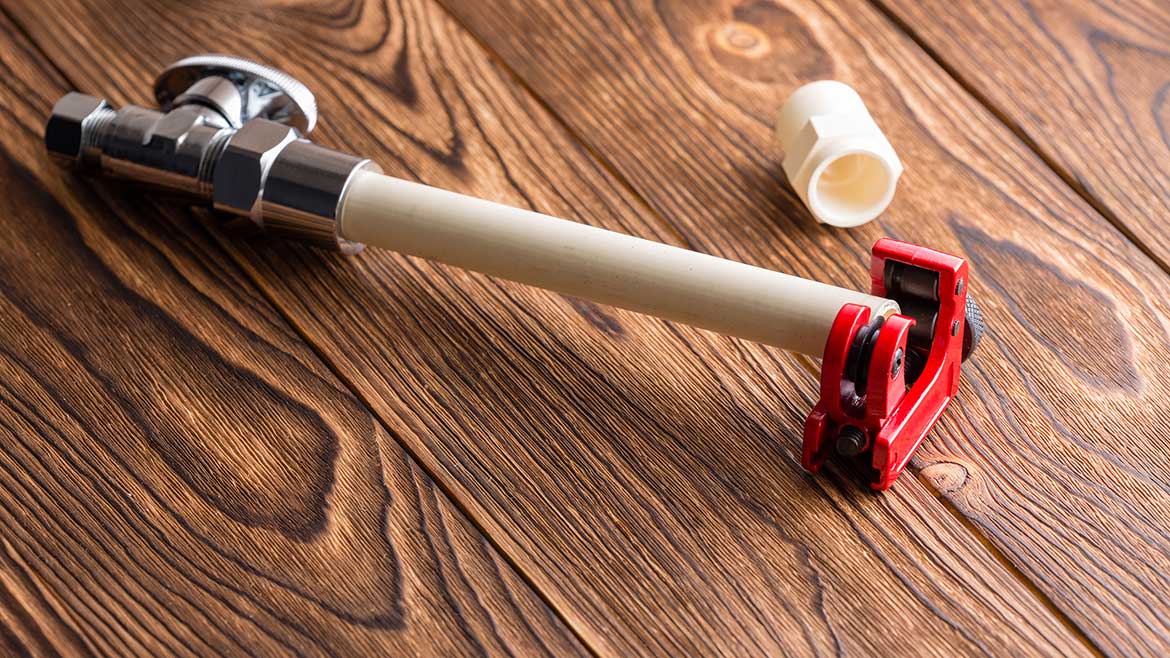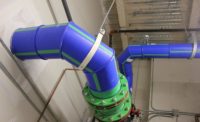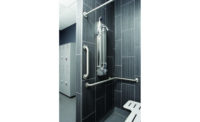Plastic plumbing systems may look similar on the outside but have different chemical compositions that impact their performance in various conditions. This article focuses on CPVC and how its chemistry and design impact performance in various operating conditions.
Where CPVC came from
CPVC was developed in the 1950s to meet the requirements of American plumbing systems. By fortifying PVC with additional chlorine molecules and other additives, a new material was created that was immune to chlorinated water and could handle the temperatures and pressures of residential plumbing systems.
The material was first used in residential plumbing systems in the late 1950s and, after proving its ability to handle U.S. water conditions, was enhanced over the next several decades to enable easier installation and improved cold weather toughness. The resulting formulation was branded FlowGuard Gold CPVC and is what you’ll find at most plumbing distributors today. FlowGuard Gold CPVC is pressure rated to 100 psi at 180° F and 400 psi at room temperature.
System design and applications
The higher pressure and temperature tolerance enabled by CPVC’s additional chlorine fortification makes it a very versatile material that can handle the various applications encountered in single-family homes and multi-story buildings such as apartments, condominiums and hotels. CPVC can, for example, support the higher pressures that may exist in taller buildings with gravity-fed distribution systems or booster pumps. It also enables more efficient sizing of hot water recirculating systems because it doesn’t have to be oversized to keep water velocities below 2 ft/sec, which is the limit for recirculation in other common materials.

Image courtesy of photovs / iStock / Getty Images Plus
The other benefit of CPVC’s immunity to chlorinated drinking water is its ability to deliver reliable performance in aggressive water conditions, which are becoming more common. The Oxidative Reduction Potential (ORP) of residential drinking water is influenced by multiple factors, including the disinfectants added to the water to make it safe. Higher ORPs (above 825 mV) have been identified as one of the factors that can lead to chlorine-related degradation in some plastic plumbing system materials.
This is significant because municipalities change the amount or type of disinfectant used in response to changing water conditions or the expansion of the distribution network, often driving up ORP in the process. One of the major changes being made today is the increased use of chlorine dioxide, which has a higher ORP than chlorine. The use of chlorine dioxide can drive ORP above the 825 mV threshold independent of the other factors contributing to ORP in the water supply. With CPVC, elevated ORPs do not introduce an increased risk of failure. If the water is safe to drink, it’s safe for CPVC pipes and fittings.
Plastic piping and water quality
The chemistry of the piping system also comes into play in protecting water quality and a plumbing system’s risk of contamination from waterborne bacteria.
Biofilm is a risk to water quality because it can contain harmful bacteria such as E. coli, coliforms and legionella. The measure of how susceptible a material is to biofilm growth is called its biofilm formation potential. Independent researchers have studied the biofilm formation potential of commonly used residential plumbing materials and found that CPVC piping consistently has a comparatively low biofilm formation potential. A controlled study conducted by Kiwa, a respected international testing and inspection institute, found the amount of legionella growing in CPVC piping to be significantly lower than in other materials studied.
CPVC is also compatible with common bacterial mitigation and remediation techniques. Optimal growing temperatures for waterborne bacteria range from 40° F to 140° F. With concerns around legionella and other waterborne contaminants growing, it is becoming more common to store and distribute hot water above 140° F, before mixing down the temperature closer to the point of use. In addition, ASHRAE 188 disinfection methods for legionella control may require subjecting the system to high ORP water. The combination of high ORP and temperatures above 140° F could accelerate degradation in some piping systems but will not harm CPVC pipes.
CPVC’s chemistry also allows the material to resist chemicals from permeating the pipe and entering the water supply.. The U.S. EPA, in its study on Permeation and Leaching, found that vinyls like CPVC are virtually impermeable at low levels of exposure, and at high levels of exposure would fail before allowing the water to become contaminated. That same study found that 82% of documented permeation incidents in the United States at the time of the study occurred in piping materials from the polyolefin family of plastics.
Pressure and flow rates
CPVC plumbing systems are similar to copper in their design. Both systems use socket-style fittings in which the pipe fits into the fitting and the two components are bonded together. The main difference is that CPVC uses a solvent weld process that eliminates the fire hazards associated with soldering copper pipes. The solvent welding process creates a bond at the fitting that is stronger than the pipe alone.
The use of socket-style fittings allows CPVC plumbing systems to deliver flow rates and pressures comparable to what can be achieved with a copper piping system. This is in contrast to plumbing systems that use fittings that are inserted into the pipe, reducing the diameter of the pipe at the fitting and restricting water flow. The extent of the difference between these two types of systems will depend on the type of fitting used but is significant in all cases.

Image courtesy of ozgurcoskun / iStock / Getty Images Plus
As a result, CPVC systems don’t experience the accelerated water velocities and associated pressure drop that occur when water jets out of the restricted area created by the fitting. In a 1/2-inch 90-degree elbow fitting, a CPVC system will experience only 0.25 – 0.30 psi of pressure drop compared to 2 to 3 psi or more for a system using insert fittings.
As pipe diameter increases, the pressure drop through fittings is dramatically reduced, so designers utilizing insert fittings often need to upsize the pipe, particularly at smaller diameters where the pressure drop is more pronounced. In a CPVC system with socket fittings and minimal pressure drop, upsizing is not generally required. This increased use of 1/2-inch and 3/4-inch pipe enabled by CPVC systems can significantly reduce the installed cost, water usage and environmental impact of the system.
Material sustainability
In addition to its other benefits, CPVC has excellent sustainability credentials. The material requires less energy to manufacture and produces fewer greenhouse gases. Its long service life, enabled by its immunity to chlorinated water, means less material is ultimately required to support the application. Plus, CPVC is recyclable through proper centers.
Engineering for reliability and performance
Engineers want to know what’s happening inside a system so they can develop the best possible design for an application. When applied to residential plumbing systems, that means understanding how the chemical composition and system components of plumbing systems impact reliability, water quality and system performance.
CPVC’s inherent immunity to chlorinated water delivers improved reliability in aggressive water conditions and increases design flexibility by enabling operation at higher temperatures and pressures. In addition, the use of socket-style fittings similar to those used in copper plumbing systems enables higher pressure at fixtures without the need for costly upsizing.



